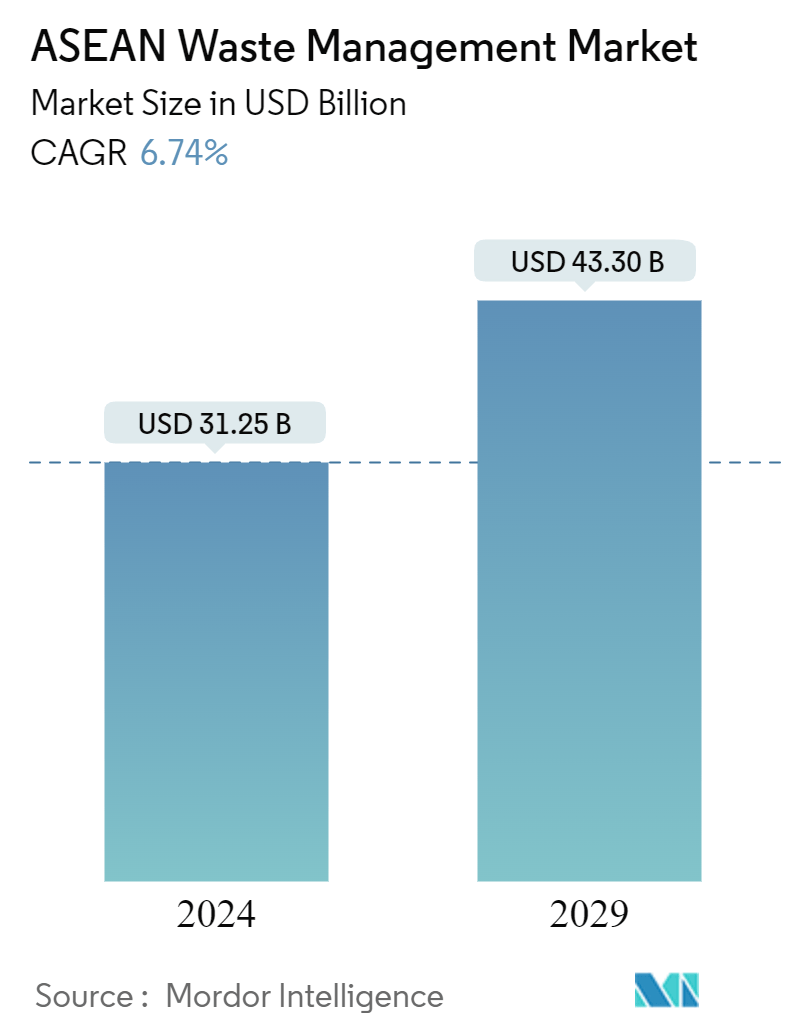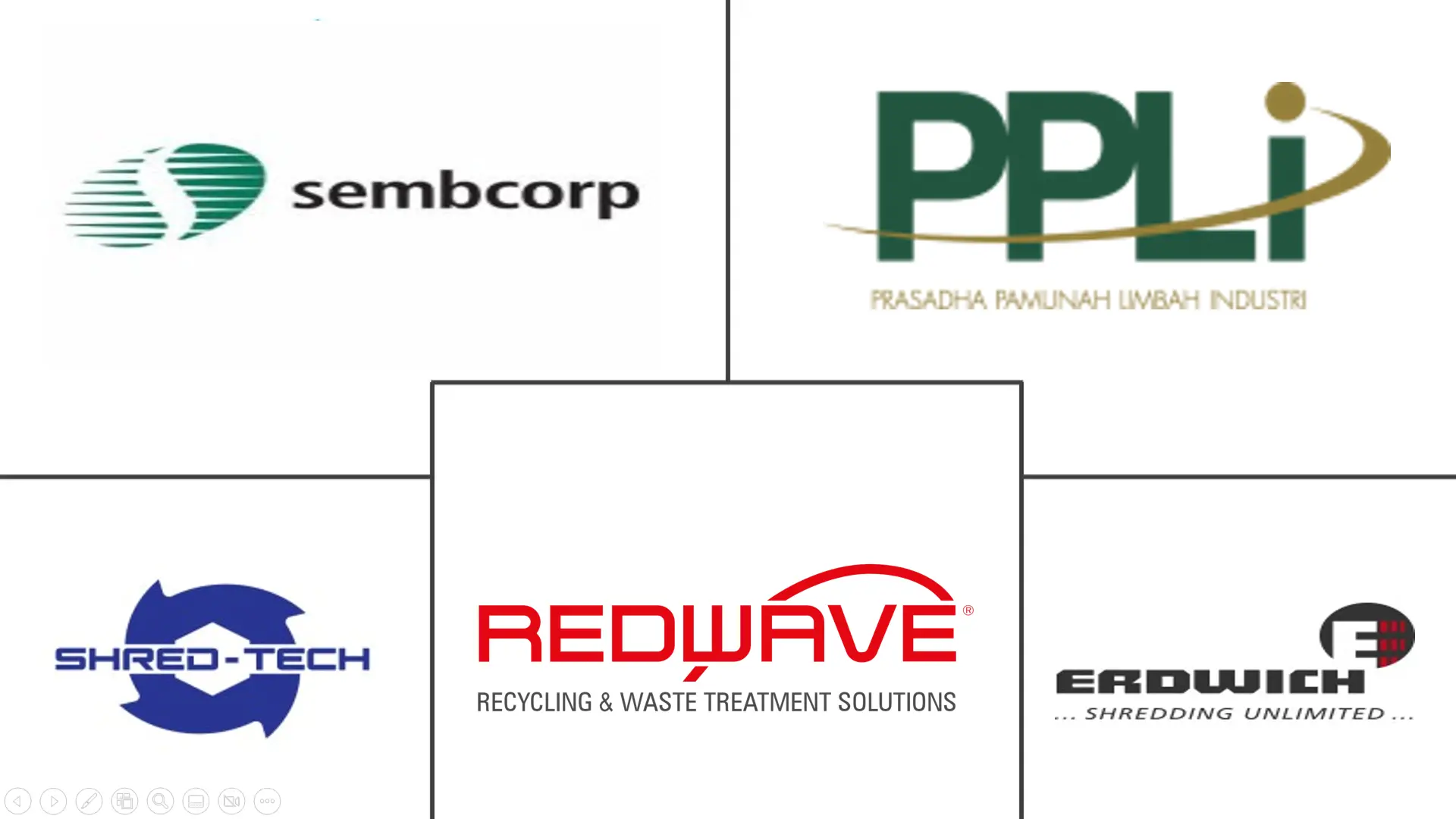Market Size of ASEAN Waste Management Industry

| Study Period | 2020 - 2029 |
| Base Year For Estimation | 2023 |
| Market Size (2024) | USD 31.25 Billion |
| Market Size (2029) | USD 43.30 Billion |
| CAGR (2024 - 2029) | 6.74 % |
| Market Concentration | Low |
Major Players
*Disclaimer: Major Players sorted in no particular order |
ASEAN Waste Management Market Analysis
The ASEAN Waste Management Market size is estimated at USD 31.25 billion in 2024, and is expected to reach USD 43.30 billion by 2029, at a CAGR of 6.74% during the forecast period (2024-2029).
ASEAN's waste management is growing at a healthy rate owing to the fast-growing economies with the growing population, increased economic activity, urbanization, and industrialization.
- In recent years, Malaysia, Vietnam, Thailand, and Indonesia have become the top destinations in Southeast Asia for the inflow of both legal and illegal waste from the US, Japan, the UK, the European Union (EU) and other countries. The sudden and sharp increase in waste imports has proved challenging for the countries in Southeast Asia, which have responded by returning containers of waste to the countries of origin, announcing bans on the import of some types of waste and tightening regulations and increasing enforcement. These measures resulted in a reduction in the amount of waste entering their countries.
- Despite current efforts, illegal waste continues to reach Southeast Asian countries. Uncontrolled and illicit waste flows are frequently hidden behind controlled or legal transboundary movements of goods - the boundaries between licit and illicit waste trafficking activities can be very thin, and the activities, actors, and modes of operation involved frequently overlap. The impact is magnified when destination countries lack enforcement capacity and/or adequate sanctions for illegal waste trade activities.
- With the increased waste generation in the region, open dumping and open burning of waste are highly prevalent in the majority of the ASEAN countries. Composting and anaerobic digestion of organic wastes, and recovery of valuable recyclables such as plastic, metal, and paper are quite common in ASEAN. Recycling, however, is more in the hands of the informal sector. Nevertheless, Singapore stands as an exception to other ASEAN countries, as it has a sound and well-structured waste management system in place. Singapore opts for waste to energy (WTE) through incineration as the major waste management option, due to its limited land resources.
- Southeast Asia's current production and consumption trajectory, as a result of its rapid growth, is increasingly putting a strain on the environment. Measures to contain the pandemic have exacerbated environmental pressures due to increased volumes of medical waste, plastics, and packaging as a result of the e-commerce boom, as well as other resource stresses. As the region's countries embark on their green recovery agenda in the aftermath of COVID-19, there is an urgent need to shift from the linear economic model of "take, make, waste" to a circular system. A circular economy is based on three principles: (i) reducing waste and pollution; (ii) reusing products and materials; and (iii) regenerating natural ecosystems.
- The region has created a framework that emphasises the importance of trade, technological innovation, and financial markets in accelerating circular transformation. The five strategic priorities outlined below will pave the way for a smooth transition to a circular economy. Standardization and mutual recognition of circular products and services.
- ASEAN countries must review existing arrangements in various sectors and harmonise standards in order to enable the trade of circular products and services and facilitate value chain integration. To mainstream and scale circularity, a widely accepted definition of circular products and services should be established through the development of a taxonomy, which can help businesses reduce compliance costs and unnecessary regulatory burdens.
ASEAN Waste Management Industry Segmentation
Waste management (or waste disposal) covers all of the procedures and actions necessary to control trash from the point of origin to the point of disposal. This covers garbage collection, transportation, treatment, and disposal, as well as the oversight and control of the waste management procedure. A complete background analysis of the ASEAN Waste Management Market, including the assessment of the economy and contribution of sectors in the economy, market overview, market size estimation for key segments, and emerging trends in the market segments, market dynamics, and geographical trends, and COVID-19 impact is included in the report.
The ASEAN Waste Management Market is segmented By Waste Type (Industrial Waste, Municipal Solid Waste, E-Waste, and Other Waste Types), By Disposal methods (Collection, Landfills, and Others), and By Geography (Indonesia, Thailand, Malaysia, Singapore, and Rest of ASEAN). The report offers market size and forecasts in value (USD billion) for all the above segments.
| By Waste type | |
| Industrial waste | |
| Municipal solid waste | |
| E-waste | |
| Other Waste types |
| By Disposal methods | |
| Collection | |
| Landfill | |
| Others |
| By Geography | |
| Indonesia | |
| Thailand | |
| Malaysia | |
| Singapore | |
| Rest of ASEAN |
ASEAN Waste Management Market Size Summary
The ASEAN waste management market is experiencing robust growth, driven by rapid economic development, urbanization, and industrialization across the region. Countries like Malaysia, Vietnam, Thailand, and Indonesia have become significant destinations for both legal and illegal waste imports, posing challenges that have led to stricter regulations and enforcement measures. Despite these efforts, illegal waste continues to infiltrate the region, complicating waste management efforts. The prevalence of open dumping and burning, alongside informal recycling practices, highlights the urgent need for a more structured approach to waste management. Singapore stands out with its advanced waste management system, primarily utilizing waste-to-energy solutions due to its limited land resources. The region's environmental strain is exacerbated by increased waste generation from the e-commerce boom and the pandemic, underscoring the necessity for a shift towards a circular economy.
The transition to a circular economy is supported by strategic frameworks emphasizing trade, technological innovation, and financial markets. ASEAN countries are encouraged to harmonize standards and develop a taxonomy for circular products and services to facilitate value chain integration. Initiatives like Indonesia's Bersih Indonesia project aim to enhance plastic waste management through public-private partnerships, with significant investments planned to improve collection, sorting, and recycling processes. The region faces a significant challenge with plastic pollution, necessitating immediate action to prevent further environmental degradation. The ASEAN waste management market is characterized by intense competition and fragmentation, with numerous local and international players vying for market share. Collaborative efforts and strategic investments are crucial for addressing the ocean plastic crisis and improving waste management infrastructure across the region.
ASEAN Waste Management Market Size - Table of Contents
-
1. MARKET OVERVIEW
-
1.1 Market Overview
-
1.2 Market Dynamics
-
1.2.1 Drivers
-
1.2.2 Restraints
-
1.2.3 Opportunities
-
-
1.3 Industry Attractiveness - Porter's Five Forces Analysis
-
1.4 Value Chain/ Supply Chain Analysis
-
1.5 Insights on the Logisitcs support and development in the waste management industry in ASEAN
-
1.6 Insights on the strategies of the rising startups venturing into the ASEAN waste management industry
-
1.7 Technological advancement and innovation in the effective waste management
-
-
2. MARKET SEGMENTATION
-
2.1 By Waste type
-
2.1.1 Industrial waste
-
2.1.2 Municipal solid waste
-
2.1.3 E-waste
-
2.1.4 Other Waste types
-
-
2.2 By Disposal methods
-
2.2.1 Collection
-
2.2.2 Landfill
-
2.2.3 Others
-
-
2.3 By Geography
-
2.3.1 Indonesia
-
2.3.2 Thailand
-
2.3.3 Malaysia
-
2.3.4 Singapore
-
2.3.5 Rest of ASEAN
-
-
ASEAN Waste Management Market Size FAQs
How big is the ASEAN Waste Management Market?
The ASEAN Waste Management Market size is expected to reach USD 31.25 billion in 2024 and grow at a CAGR of 6.74% to reach USD 43.30 billion by 2029.
What is the current ASEAN Waste Management Market size?
In 2024, the ASEAN Waste Management Market size is expected to reach USD 31.25 billion.

